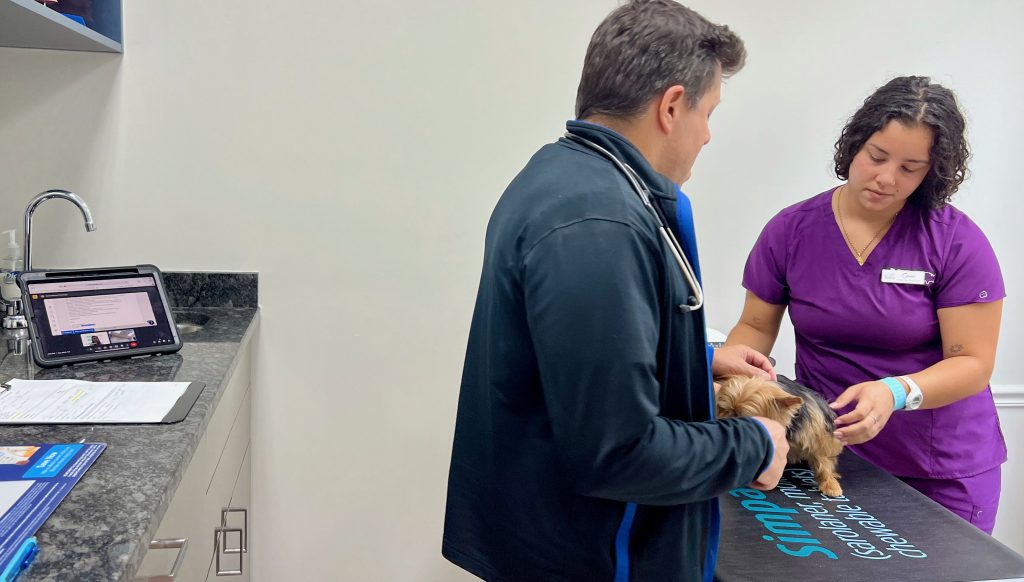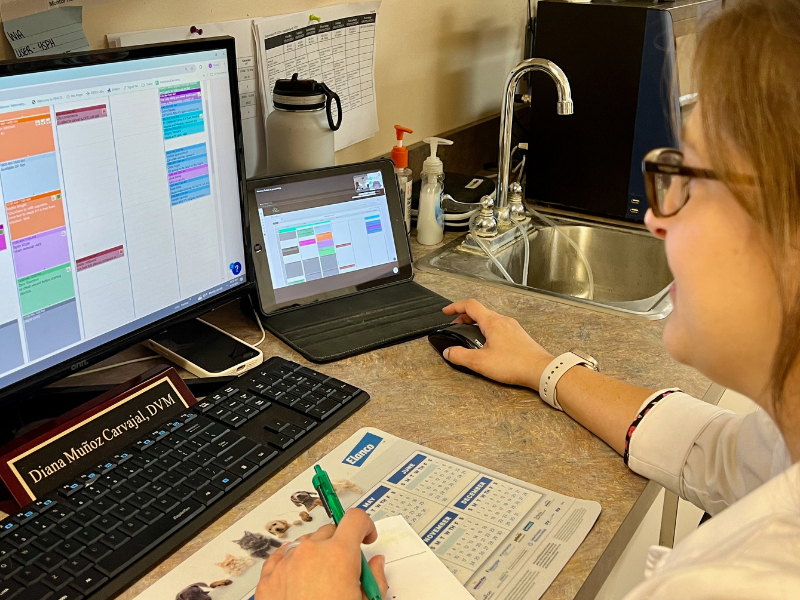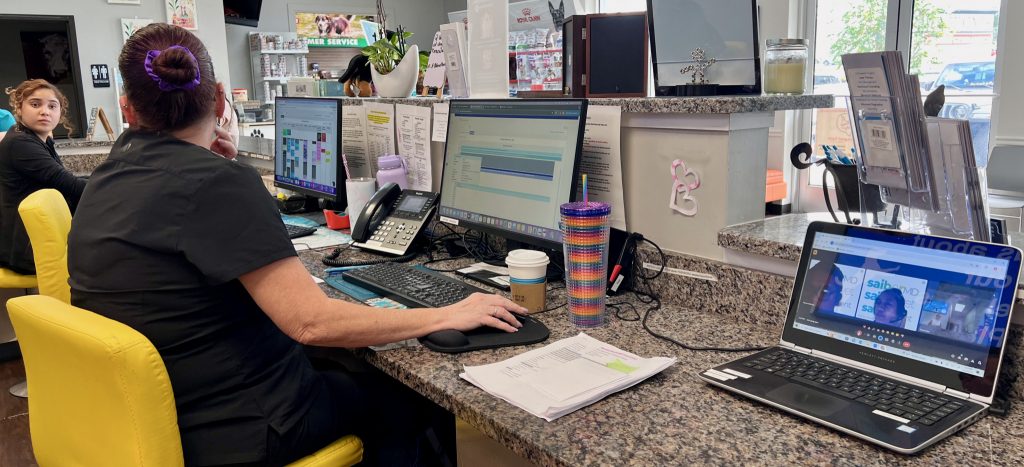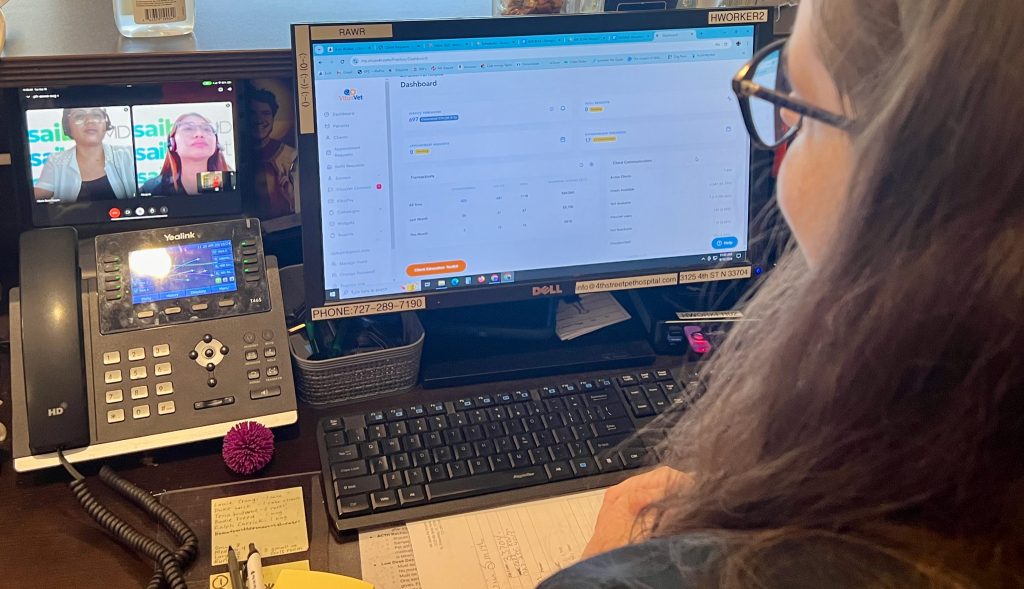
Timothy Jones, DVM, saw 19 patients on Saturday and credits the productivity upshot to his virtual medical assistant (VMA). While he sees patients as an associate veterinarian at Seven Oaks Pet Hospital and Pet Urgent Care of Wesley Chapel in Wesley Chapel, Fla., Dr. Jones carries a tablet where his scribe appears on a small video window along with the practice information management software (PIMS). The scribe opens the patient record and types medical notes, prescription labels, and treatment plans based on Jones’ exam findings and recommendations.
Jones’ scribe is Jessica Serrano, a Philippines-trained pharmacist with SaiberAssist, a company supporting veterinarians, physicians, dentists, accountants, attorneys, and real estate agents with virtual administrative and medical assistants. Dr. Jones works with the same VMA every shift.
“Before I had my scribe, I had to stop and type notes,” says Jones. “I have more face time with clients. My scribe lets me see more patients.”
When he performs surgery, Serrano enters information from surgical sheets into patient records and prepares discharge instructions.
Here are eight benefits of using VMAs:
1) Get help with records and administrative tasks
VMAs act as live scribes, supporting recordkeeping, processing medication refills, creating treatment plans, sharing lab results with clients, creating discharge instructions, and managing follow-up communication with clients via texts, emails, and calls.
Diana Munoz, DVM, owner of 4th Street Pet Hospital in St. Petersburg, Fla., says she’s better at multi-tasking with the support of VMA Hennes Tobiasis, who is a Philippines-trained physical therapist with SaiberAssist.
“Virtual assistants are better than AI because you have a real person,” says Dr. Munoz. “We’ve cut our doctors’ administrative time in half.”
Tobiasis calls clients about pets’ normal lab results while Munoz contacts pet owners with abnormal results.

2) See more patients
VMAs help veterinarians at Seven Oaks Pet Hospital and Pet Urgent Care of Wesley Chapel see four to five more patients per doctor per day.
“My doctors save one to two hours per day,” says Sree Reddy, DVM, who owns SaiberAssist and Seven Oaks Pet Hospital, and Pet Urgent Care of Wesley Chapel.
For three years, Dr. Reddy has worked with VMA Melton Desales, DVM, who received his veterinary degree from the University of the Philippines Los Baños in Laguna, Philippines. Dr. Desales also trains new VMAs as SaiberAssist’s training and implementation specialist.
As Reddy discusses exam findings and recommendations with clients, Desales updates patient records, prepares treatment plans, and creates prescription labels. His VMA also keeps Reddy organized, telling him when lab results need to be reviewed and which clients need follow-up communication. “I won’t see patients without Melton,” Reddy says.

3) Increase practice revenue and doctor compensation
Reddy pays his veterinarians on production, so seeing up to five more patients per day increases their paychecks along with hospitals’ income. “I also get my breaks,” says Jones. “Our scribes are unsung heroes.”
4) Improve employee retention
In addition to supporting doctors and technicians, VMAs help client service representatives (CSRs) and managers. At 4th Street Pet Hospital, two VMAs work as remote CSRs. Rose Anana and Marjorie Ceballos answer all incoming calls, schedule appointments, take medication refill requests, and manage text and email communication with clients.
“Rose and Marjorie allow more time for us to focus on in-person client service,” says Ashley Baker, office manager. “They let our CSRs do their jobs to a higher standard. I treat them the same as our regular employees. We show them the same respect and appreciation.”
More than half of veterinary CSRs last less than two years in their jobs.1 At Seven Oaks Pet Hospital, CSRs have more than three years of retention. Reddy credits the support of VMAs.
5) Deliver consistent service
Practices assign VMAs to specific in-person team members who work together every day. This lets the VMA know doctor and staff member preferences. When Jones takes his lunch break, Serrano takes hers.
6) Integrate phones and computers with technology tools
VMAs can log into cloud-based PIMS or use remote-access apps for server-based PIMS. VoIP phone systems let VMAs manage calls from anywhere.
“Our virtual assistants pick up calls faster because they are not multi-tasking between phone and in-person duties,” says Samantha McKilly, practice manager at Seven Oaks Pet Hospital. VMAs Nash Diazon and Raymund Surban, who are Philippines-trained registered nurses, have supported its CSR team for three years.

7) Assist CSRs with administrative and revenue-generating duties
At 4th Street Pet Hospital, VMAs make overdue reminder calls, handle record requests, manage online and app appointment requests, take medication refill requests, call clients who have not replied to text and email confirmations, and help manage emails and texts. “Make virtual assistants part of your team,” advises Baker. “We include them in our staff meetings and list them on our website.” VMAs even order lunch for staff meetings and have it delivered for in-person co-workers.
8) Reduce staff costs
SaiberAssist charges $10 per hour for VMA services and bills practices weekly. Teams work with the same VMAs every day. No contracts are required. Hospital leaders interview and choose VMA candidates who will best serve their practices. VMAs learn your PIMS and protocols to support daily workflow.
“Teach them right from the start,” says Baker. “Have standard operating procedures on how the hospital runs.” She provides internal CSR training manuals for her VMAs just as she would for new in-person CSRs. Existing VMAs also help train new ones.
Dr. Reddy saves $500,000 per year in staff wages and benefits for his practices while increasing productivity. Seven Oaks Pet Hospital also uses an administrative VMA with a master’s in business administration to audit records for missed charges, contact clients about failed payments for wellness plans, prepare financial reports, and do bookkeeping.
Virtual assistants can help solve staffing shortages for practices and help teams increase productivity and revenue. “Virtual assistants are our first line of defense,” says Baker. “We couldn’t live without them.”
Wendy S. Myers, CVJ, knows the right words will lead clients to accept your medical advice, driving patient and practice health. As founder of Communication Solutions for Veterinarians, she teaches practical skills through online courses, conferences, and onsite consulting. Myers’ experience as a partner in a specialty and emergency hospital helped her understand issues owners and managers face. Learn how she can train your team at the Communication Solutions for Veterinarians website.
Reference
- How to Help Your Veterinary Front-Desk Team with Burnout. https://petdesk.com/blog/help-your-veterinary-front-desk-burnout. Accessed Sept. 27, 2024.
